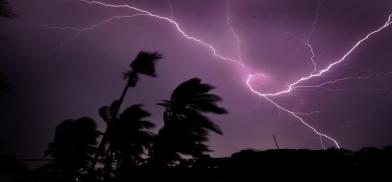Lightning strikes killing more people than ever in India
A staggering 1700 people have lost their lives to lightning strikes in India this year! In Bihar, more than 400 people have lost their lives from lightning strikes during the year, recording a 168 per cent increase over the previous year

A staggering 1700 people have lost their lives to lightning strikes in India this year! In Bihar, more than 400 people have lost their lives from lightning strikes during the year, recording a 168 per cent increase over the previous year.
Some of the states that have been at the receiving end of bolt from the blue, literally, are Punjab, Bihar, Uttar Pradesh, Jharkhand, Madhya Pradesh, Haryana, Puducherry, Himachal Pradesh and West Bengal. In Punjab, the increase in number of lightning strikes has been a staggering 331 per cent annually, according to a study done by the reputed Down to Earth environment protection magazine.
Overall, 1,697 people were struck down dead by lightning in India between March 2020 and April 2021, the magazine was quoted by TNA as saying.
“There is growing scientific evidence that climate change may be sparking more lightning across the world. Rapid urbanisation and population growth have guaranteed an intensification of human exposure to lightning hazard,” says Down To Earth managing editor Richard Mahapatra.
The number and frequency of lightning strikes is increasing globally. Between April 2020 and March 2021, 18.5 million lightning strikes were recorded in India. This was a 34 per cent increase from the 13.8 million strikes between April 2019 and March 2020.
These statistics were shared at a webinar on lightning strikes recently organised by Centre for Science and Environment (CSE) and Down To Earth magazine. The webinar attempted to understand why lightning strikes were increasing in numbers, and their connection to climate change and growing urbanisation.
Global warming effect?
A 2015 California University study has projected that an increase in average global temperatures by 1ºC would increase the frequency of lightning by 12 per cent. Another paper, soon to be published in the journal Atmospheric Chemistry and Physics, warns that the frequency and intensity of lightning strikes in India are expected to increase by 10-25 per cent and 15-50 per cent respectively by the end of the century.
A foreboding dimension of the surge in lightning strike numbers is their link to forest fires. “Scientists from the Hemvati Nandan Bahuguna Garhwal University in Shrinagar, Uttarakhand and the Indian Institute of Technology, Kanpur, have studied the concentration of cloud condensation nuclei (CCN) in different weather conditions in the central Himalayan region. They have found a five-time higher concentration of CCN in the atmosphere during forest fires as against during rains. In May 2021, researchers in Australia linked excess CCN to the increased number of lightning strikes during the 2019-20 Australia forest fires,” says Kiran Pandey, programme director of CSE’s environmental resources unit.
The sharp rise in fatalities has prompted the India Meteorological Department (IMD) to start lightning forecasts from April 1, 2019. Lightning India Resilient Campaign (LRIC), a joint initiative of several bodies such as Climate Resilient Observing-Systems Promotion Council (CROPC), National Disaster Management Authority, IMD, Union Ministry of Earth Sciences and others aims to reduce the number of deaths due to lightning strikes to less than 1,200 a year by 2022.
“The LRIC says its campaign has been successful in bringing down deaths by more than 60 per cent within two years. Dedicated efforts by governments of states like Andhra Pradesh and Odisha have led to a 70 per cent reduction in fatalities,” says Akshit Sangomla, senior reporter with Down To Earth, was quoted as saying.
“The lightning incidents recorded reveal that seasonality of lightning is different for different states. Therefore, it is important that the lightning risk management programme for each state is customised according to the seasonality, intensity and frequency of lightning. States should undertake lightning micro-zonation for the regions inside their boundaries, depending on their geography, to handle the disaster and death risks better. These are LRIC’s recommendations and they make a lot of sense,” says Pandey.
Says Mahapatra: “We may not be able to prevent every single lightning fatality, but we can definitely decrease their number substantially. The first step is to create general awareness about some universal safe practices, for example, to stay indoors for up to 30 minutes after the last flash if the time between a lightning flash and thunder is less than 30 seconds. The next steps would involve making use of the evolving science and technology on the subject and decentralising predictions and risk management.” (SAM)









Post a Comment